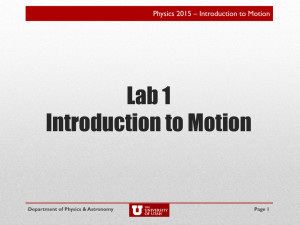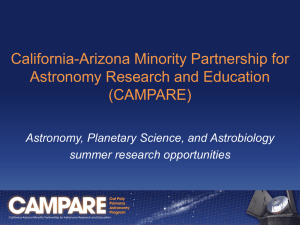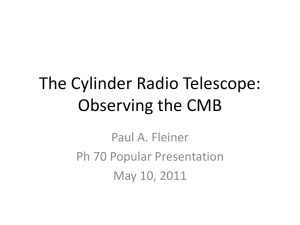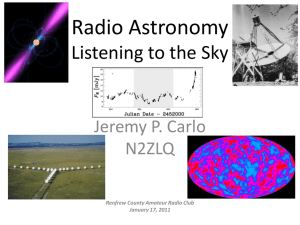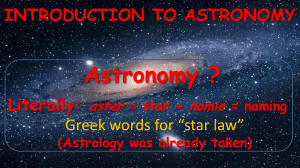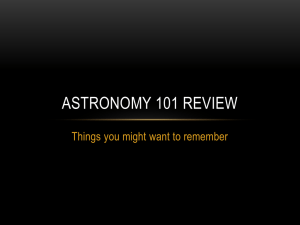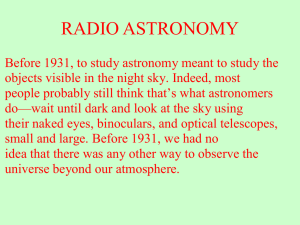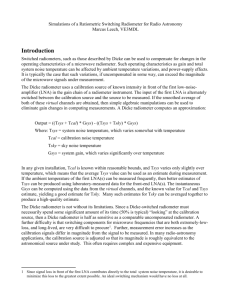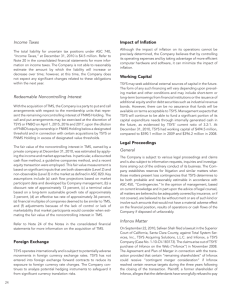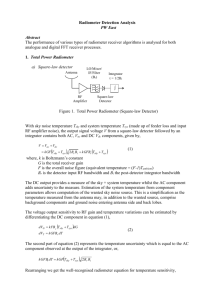A Crash Course in Submillimetre Astronomy and
advertisement
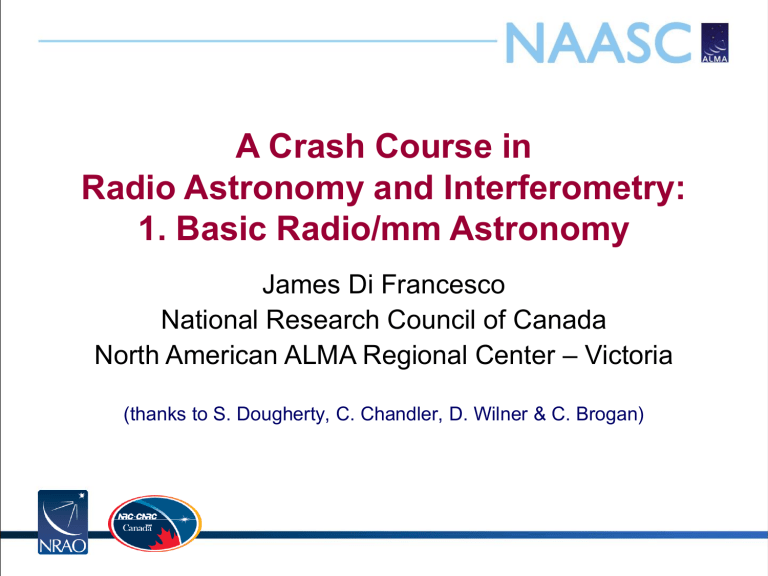
A Crash Course in Radio Astronomy and Interferometry: 1. Basic Radio/mm Astronomy James Di Francesco National Research Council of Canada North American ALMA Regional Center – Victoria (thanks to S. Dougherty, C. Chandler, D. Wilner & C. Brogan) Basic Radio/mm Astronomy Intensity & Flux Density EM power in bandwidth dn from solid angle dW intercepted by surface dA is: dW In dWdAdn Defines surface brightness Iv (W m-2 Hz-1 sr-1 ; aka specific intensity) Flux density Sv (W m-2 Hz-1) – integrate brightness over solid angle of source Sv Ws Iv dW Convenient unit – the Jansky 1 Jy = 10-26 W m-2 Hz-1 = 10-23 erg s-1 cm-2 Hz-1 Note: Sv Lv /4 d 2 ie. distance dependent W 1/d 2 In Sv /W ie. distance independent Basic Radio/mm Astronomy Surface Brightness In general surface brightness is position dependent, ie. In= In(q,f) 2kv 2T(q ,) In (q ,) c2 (if In described by a blackbody in the Rayleigh-Jeans limit; hn/kT << 1) Back to flux: 2kv2 Sv W Iv (q ,)dW 2 s c T(q ,)dW In general, a radio telescope maps the temperature distribution of the sky Basic Radio Astronomy Brightness Temperature Many astronomical sources DO NOT emit as blackbodies! However…. Brightness temperature (TB) of a source is defined as the temperature of a blackbody with the same surface brightness at a given frequency: 2kv 2TB In c2 2kv2 This implies that the flux density Sv W s Iv dW c 2 T dW B Basic Radio Astronomy What does a Radio Telescope Detect? Recall : dW In dWdAdn Telescope of effective area Ae receives power Prec per unit frequency from an unpolarized source but is only sensitive to one mode of polarization: Prec 1 In AedW 2 Telescope is sensitive to radiation from more than one direction with relative sensitivity given by the normalized antenna pattern PN(q,): Prec 1 Ae In (q ,)PN (q ,)dW 2 4 Basic Radio Astronomy Antenna Temperature P kT Johnson-Nyquist theorem (1928): Power received by the antenna: Prec Prec Ae 2 kTA In(q ,)P (q ,) dW N 4 Ae TA In (q ,)PN (q ,) dW 2k 4 Antenna temperature is what is observed by the radio telescope. A “convolution” of sky brightness with the beam pattern It is an inversion problem to determine the source temperature distribution. Basic Radio/mm Astronomy Radio Telescopes The antenna collects the E-field over the aperture at the focus The feed horn at the focus adds the fields together, guides signal to the front end Basic Radio/mm Astronomy Components of a Heterodyne System Feed Horn Back end Power detector/integrator or Correlator • Amplifier – amplifies a very weak radio frequency (RF) signal, is stable & low noise • Mixer – produces a stable lower, intermediate frequency (IF) signal by mixing the RF signal with a stable local oscillator (LO) signal, is tunable • Filter – selects a narrow signal band out of the IF • Backend – either total power detector or more typically today, a correlator Basic Radio/mm Astronomy Origin of the Beam Pattern • Antenna response is a coherent phase summation of the E-field at the focus • First null occurs at the angle where one extra wavelength of path is added across the full aperture width, i.e., q ~ l/D On-axis incidence Off-axis incidence Basic Radio/mm Astronomy Antenna Power Pattern Defines telescope resolution • The voltage response pattern is the FT of the aperture distribution • The power response pattern, P(q ) V2(q), is the FT of the autocorrelation function of the aperture • for a uniform circle, V(q ) is J1(x)/x and P(q ) is the Airy pattern, (J (x)/x)2 Basic Radio/mm Astronomy The Beam The antenna “beam” solid angle on the sky is: WA P(q,f)dW 4 Telescope beams @ 345 GHz D (m) q (“) AST/RO 1.7 103 JCMT 15 15 LMT 50 4.5 SMA 508 0.35 ALMA 15 000 0.012 Sidelobes NB: rear lobes! Basic Radio/mm Astronomy Sensitivity (Noise) Unfortunately, the telescope system itself contributes noise to the the signal detected by the telescope, i.e., Pout = PA + Psys Tout = TA + Tsys The system temperature, Tsys, represents noise added by the system: Tsys = Tbg + Tsky + Tspill + Tloss + Tcal + Trx Tbg = microwave and galactic background (3K, except below 1GHz) Tsky = atmospheric emission (increases with frequency--dominant in mm) Tspill = ground radiation (via sidelobes) (telescope design) Tloss = losses in the feed and signal transmission system (design) Tcal = injected calibrator signal (usually small) Trx = receiver system (often dominates at cm — a design challenge) Note that Tbg, Tsky, and Tspill vary with sky position and Tsky is time variable Basic Radio/mm Astronomy Sensitivity (Noise) In the mm/submm regime, Tsky is the challenge (especially at low elevations) In general, Trx is essentially at the quantum limit, and Trx < Tsky ALMA Trx GHz Band 3 84-116 Trx (K) < 37 Band 6 211-275 < 83 Band 7 275-370 < 83 Band 9 602-720 < 175 “Wet” component: H2O “Dry” component: O2 Basic Radio/mm Astronomy Sensitivity (Noise) Q: How can you detect TA (signal) in the presence of Tsys (noise)? A: The signal is correlated from one sample to the next but the noise is not For bandwidth Dn, samples taken less than Dt = 1/Dn are not independent (Nyquist sampling theorem!) Time t contains N t /Dt t Dn independent samples For Gaussian noise, total error for N samples is DTA 1 Tsys t Dn TA TA SNR t Dn DTA Tsys 1/ N that of single sample Radiometer equation Next: Aperture Synthesis

